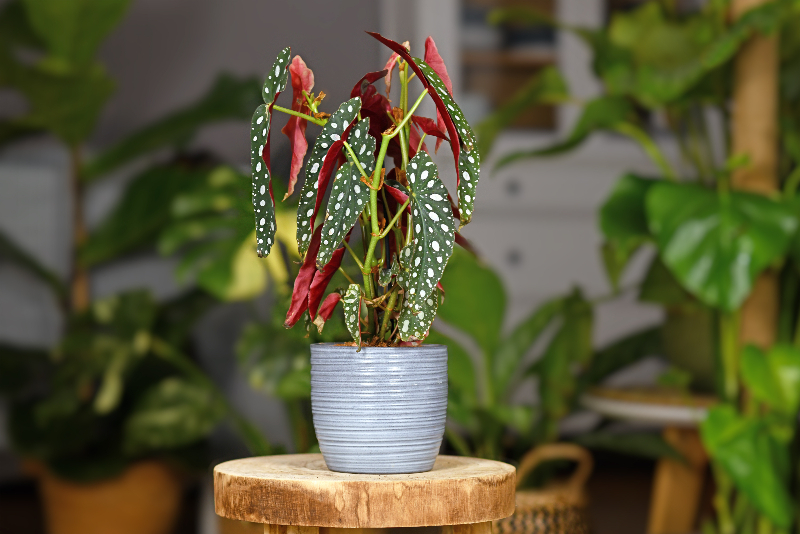 Polka dot begonia is a beautiful evergreen tropical plant native to the hot and humid forests of Brazil. Polka dot begonia, also known as begonia maculata, receives its name from characteristic white dots on its bright-green leaves. Polka dot begonias are easy-to-care-for plants suitable for a beginner interested in indoor gardening and will make a fun and colorful addition to any home.
Polka dot begonia is a beautiful evergreen tropical plant native to the hot and humid forests of Brazil. Polka dot begonia, also known as begonia maculata, receives its name from characteristic white dots on its bright-green leaves. Polka dot begonias are easy-to-care-for plants suitable for a beginner interested in indoor gardening and will make a fun and colorful addition to any home.
What Is Polka Dot Begonia: Origin and Description
Begonia maculata is an evergreen perennial plant originating from the tropical forests of southeastern Brazil. The polka dot begonia plant commonly grows in rainforests in the states of Rio de Janeiro and Espírito Santo. This plant variety has also been introduced to other countries in the region, including Mexico, Argentina, and Cuba. The conditions of these plants’ natural habitat dictate the environment they need at home to thrive.
Polka dot begonia is a plant species that belongs to the family Begoniaceae, genus Begonia. The species known as begonia maculata are recognized by its prolonged leaf shape covered by white or silver dots, giving the plant its common name. Polka dot begonias can grow up to four feet in height. These plants also develop cascading white flowers in the growing season that make their appearance even more striking.
Other names by which polka dot begonia or begonia maculata is known are clown begonia, wightii begonia, spotted begonia, or spotty begonia.
Features of Begonia Maculata
Polka dot begonia is an evergreen plant with bright green foliage made of uniquely shaped leaves that remind some of the shapes of an angel wing. This plant is also a variety of cane begonias, which is a group of begonia plants, also known as angel wing begonia, recognized by their thick bamboo-like stems and long leaves with sharp edges.
|
Names |
Polka dot begonia, clown begonia, wightii begonia, spotted begonia, spotty begonia |
|
Scientific name |
Begonia maculata |
|
Origin |
Tropical forests of Brazil |
|
Size |
3–4 feet |
|
Colors |
Bright green with silver dots |
|
Soil |
Soft well-draining soil |
|
Water |
Allow top inch to dry in between waterings |
|
Temperature |
65°F and 86°F |
|
Light |
Bright indirect light |
|
Level |
Beginner/intermediate |
Begonia Maculata Care
Taking care of a polka dot begonia is not very difficult and can be easily done by a novice plant grower. However, these begonias require some specific conditions to be maintained to stay healthy, such as a fixed temperature range, regular watering, moderate light, and high humidity. However, it is important to avoid overwatering and overmisting that can lead to the development of plant disease and appearance of pests.
Light
Polka dot begonia is a light-loving plant that enjoys some bright light now and then. However, begonia maculata will benefit from staying out of the direct sun. Direct sunlight can cause fading of the silver spots, making the plant so special, as well as turn the plant’s leaf tips brown.
The best solution is to put the polka dot begonia in bright indirect light at home. In the winter, the plant can benefit from being placed on a window sill on the southern side, while the eastern or western exposure works well throughout the year. Polka dot begonia can also survive in limited light, but this won’t be beneficial for the plant for longer periods of time. When the begonia is not getting enough light, its leaves will start losing color.
Water
The polka dot begonia plants enjoy moist soil and, like most houseplants, require regular watering. However, polka dots will most likely suffer from overwatering, so it’s important to avoid soggy soil at all costs. Begonia maculata doesn’t tolerate soggy roots for a long time and will develop root rot if that’s the case.
To water the polka dot begonia, allow the top inch of the soil to dry before the next portion of water. If the soil is still moist, it’s better to not water the begonia yet. Polka dot begonias should be watered every 3–4 days in the summer season and once a week in the winter.
Temperature
Polka dot begonia is a great plant for indoor gardening since it enjoys relatively high stable temperatures that are harder to maintain outdoors. The best temperature range for begonica maculata plants is between 65°F and 86°F. It’s important to keep the plant out of drafts and never allow the temperature in the room to go below 59°F because it can cause the death of the plant.
Humidity
Polka dots thrive in relatively high humidity, similar to the tropical environment of its natural habitat. It’s best to maintain the humidity level at 45% or higher. Use a digital hygrometer to ensure the level of humidity is consistent. It’s especially important to maintain high humidity levels in the winter, since the heating tends to make the air drier.
The best way to keep the humidity level stable is to add a humidifier in the room and keep it near the plant. Or, introduce a pebble tray covered with water to ensure consistent humidity. To do so, put a layer of pebbles on a tray, then pour some water to cover the stones about halfway, and place the pot with begonia maculata on top of the tray.
Soil
Begonia maculata benefits from a well-draining soil, like most houseplants. A commercial potting mix or palm soil mix are appropriate options for a polka dot begonia plant. But a grower can also make a mix of soil at home to enhance the quality of conditions for the polka dot begonia. Try mixing some perlite or and wood chips for better humidity and aeration.
Fertilizer
Polka dot begonias benefit from regular fertilization every two to four weeks to ensure balanced growth and development of the plant. It’s best to choose a water-soluble fertilizer for a polka dot begonia, or use small amounts of compost to feed the plant. Fertilize the begonia in the growing period from April to September to keep the plant healthy and maintain its bright colors. Stop feeding in the colder period between October and March because the growth of polka dot begonias slows down significantly in winter months, so fertilizer would be ineffective.
When feeding begonia maculata, flush the soil with water every two to three months to maximize the effect of fertilizer and prevent the minerals from building up in the top layers. To do so, pour a lot of water through the soil and allow it to drain through the draining holes of the pot. In addition, make sure not to overfeed the plant because too much fertilizer can burn the plant and damage it in the long term.
Pests
Begonia maculata can sometimes be affected by pests, like whiteflies and mealybugs. However, the use of pesticides may be ineffective in these cases because these pests are too small and whiteflies tend to fly around when disturbed, remaining unaffected by the solution. Insecticidal soap can be more efficient when dealing with these pests.
Grooming and Pruning
Because polka dot begonias are bushy plants with rich foliage, begonia maculata care also involves meticulous grooming. Polka dots tend to grow quite large, with some plants reaching five feet in height, which can be achieved easier by pruning. Cutting the stems can help to promote quicker growth and stimulate outward rather than upward development. The easiest way to cut the stems is to cut off a part of the stem with a few leaves.
Polka Dot Begonia Flower
Begonia maculata develops cascading pink or white flowers during the flowering season in spring and summer. The fully blooming flowers are a striking image and made the polka dot begonia even more beautiful. To promote the growth of flowers on polka dot begonia, place the pot with the plant in bright light, for example, on a window sill that is facing east or west.
Begonia Maculata Wightii Toxicity
Some toxins contained in the stems and leaves make begonia maculata toxic. Polka dot begonias are thought to be toxic to pets, like cats and dogs, so it’s best to keep this plant in a place where animals cannot reach it. Signs of poisoning can include vomiting and excessive drooling. If these symptoms are noticed, take the pet to the veterinarian as soon as possible.
Polka Dot Begonia Maculata Propagation
Polka dot begonia propagation is considered a relatively easy process. Begonia maculata can be propagated either in water or in soil. Start the process by cutting the stem from the original plant with a few leaves on it. Stem cuttings should be at least two inches long to survive and grow. After making a cut, place the stem cuttings straight into water and wait for a few weeks before they develop roots. Or, dip the end of the cutting in root hormone and put it straight into fresh soil.
It’s best to propagate polka dot begonia in the spring or summer during its primary growing season. When making cuttings, make sure to use proper cutting tools to avoid unnecessary damage to the plant.
Spotted Begonia Re-potting
Polka dot begonia plants benefit from re-potting every year. Because the roots of the plants are very dense, they tend to wear out the soil quickly, which is why potting them into fresh soil every year is good for these plants.
Begonia maculata does not need changes in pot size too often. These plants can be placed in the same pot with every re-potting, but in fresh soil. However, if the begonia stops growing, a one size bigger pot is possibly required. Polka dots grow heavy foliage, so choose a heavy pot that will hold the plants steady.
Diseases and Common Problems in Caring For Begonia Maculata
Though begonia maculata care remains easy, keep in mind that these plants can suffer from a number of common diseases that should be treated as soon as possible to ensure the survival of the plant.
Powdery Mildew
Powdery mildew is a fungal infection that affects polka dot begonia frequently. The signs of powdery mildew disease include a powdery-looking substance on the plant’s leaves. Treat the infection by removing the affected areas and spraying the begonia with a fungicide solution. To prevent the disease, which can be hard and long to treat, make sure not to overwater the plant and always allow the top inch of the soil to dry in between waterings.
Botrytis
Botrytis is known as another fungal disease that affects begonia maculata. The cause of botrytis is usually in soggy roots that come as a result of overwatering, as well as poor air circulation in the room. The disease manifests itself in wet brown spots on the plant and lowering leaves. Botrytis can be treated with the removal of affected areas and spraying the plant with fungicide.
Root and Stem Rot
Both conditions come as a result of overwatering and can be prevented by ensuring the soil is properly drained and ensuring no overwatering occurs. Stem and root rot cause the plant’s stems go black.
Bacterial Leaf Spots
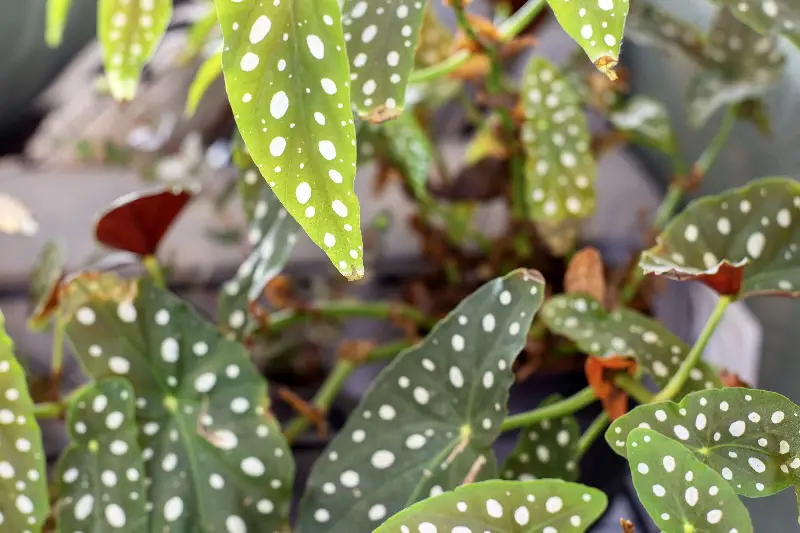 Bacterial leaf spots are represented by noticeable spots on the leaves. This condition is very contagious and can survive in the plants from one season to another, which is why the infected plants should be discarded.
Bacterial leaf spots are represented by noticeable spots on the leaves. This condition is very contagious and can survive in the plants from one season to another, which is why the infected plants should be discarded.
Conclusion
Polka dot begonia is a beautiful and unique plant that will suit any owner, regardless of their level of experience. Begonia maculata care requires minimal effort and makes this plant a great addition to any household.
FAQs About Polka Dot Begonia
The following section of the article answers some of the most commonly asked questions about begonia maculata care.
Are Polka Dot Begonias Rare?
Yes, polka dot begonias are rare exotic plants. However, thanks to the progress made in houseplant cultivation over the years, today begonia maculata is relatively easy to find in plant stores across the United States.
How Quickly Do Polka Dot Begonias Grow?
Polka dot begonias grow relatively quickly. Like most houseplants, these plants’ growing season falls on late spring and summer which is when maximum growth can be achieved with proper care and fertilization. The polka dot begonia can reach four meters in height and become a brilliant floor plant to decorate the house.
Do Polka Dot Begonias Need to Be Staked?
Polka dot begonias may need staking as they grow taller. Because polka dot begonias tend to grow upward, they need some support, which is when staking can come in handy. Staking can help remove the pressure from the plant, make sure the begonia grows in a balanced way, as well as protect the polka dot from accidents at home.
Why Is My Polka Dot Begonia Dying?
A polka dot begonia may suffer from too much sun or too much water. If the plant was placed in direct sunlight for too long, it may display yellow leaves and other signs of sunburn, which is a signal to remove the plant from bright light. When overwatered, the plant will show symptoms, such as black and puffy stems, or even signs of fungal diseases.

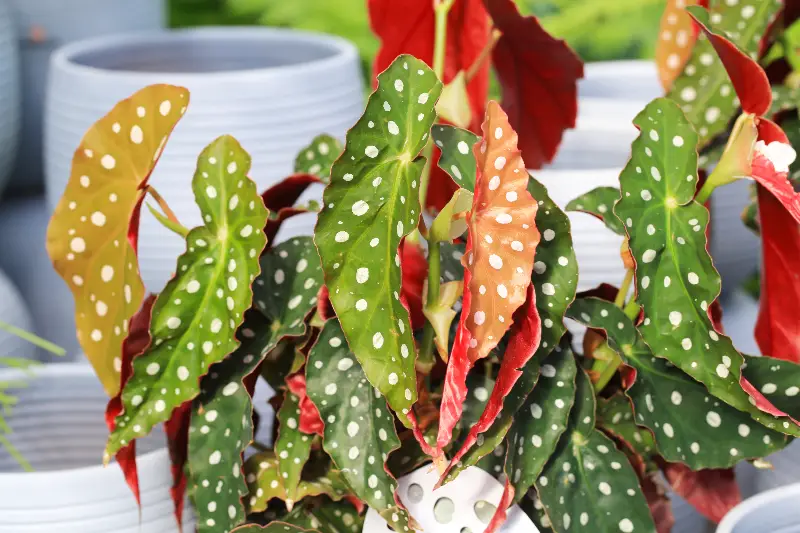
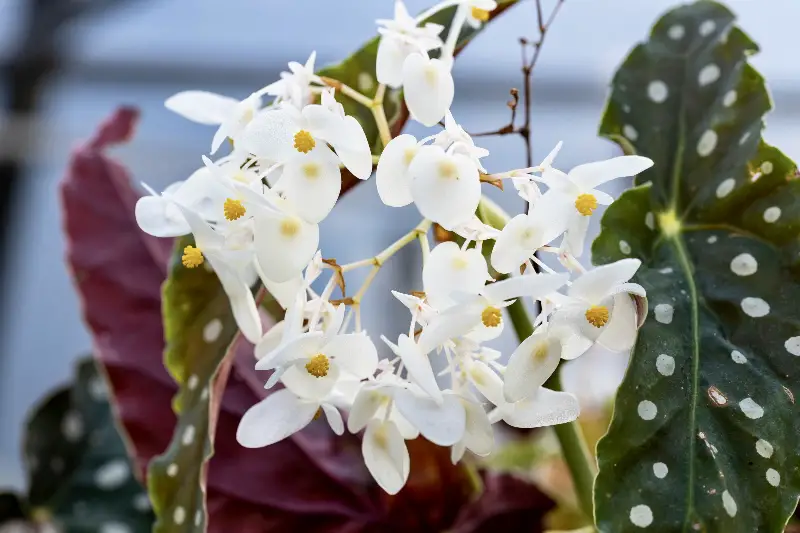
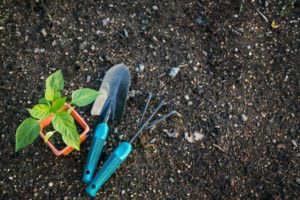

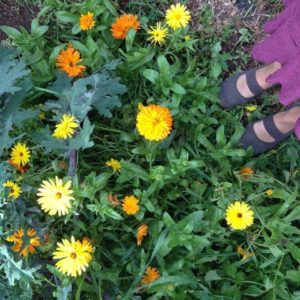
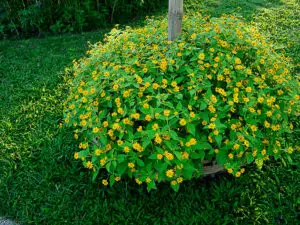

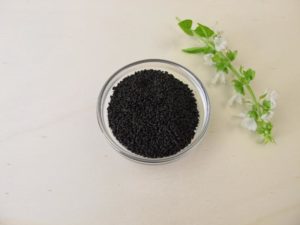
“I’ve always loved the dramatic look of the Polka Dot Begonia—thanks for the deep dive into its background!”
Polka dot begonia is a beautiful evergreen tropical plant. I like this.